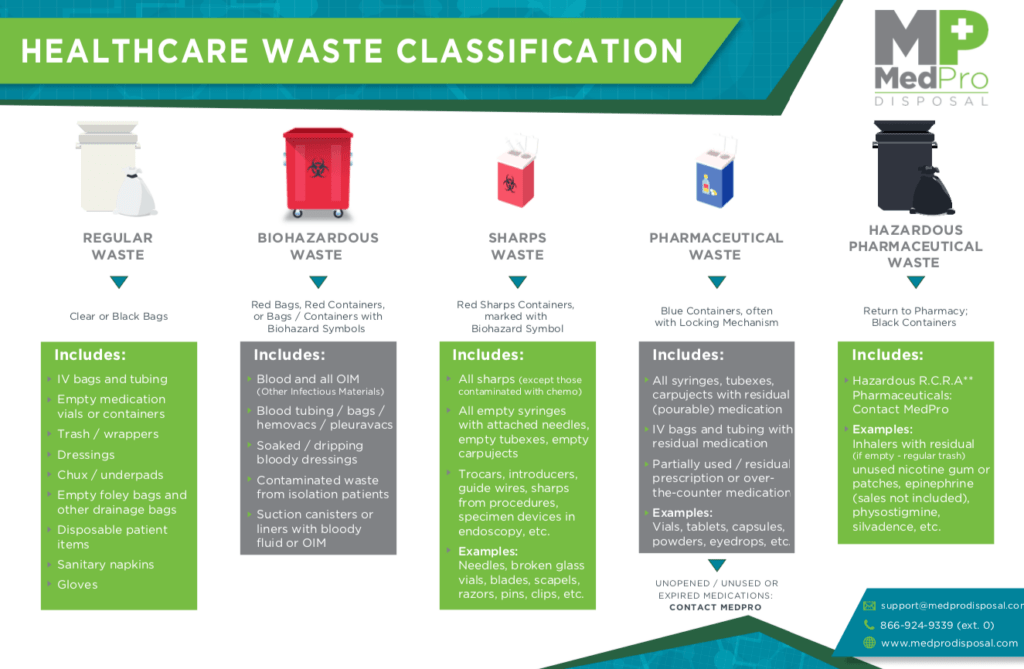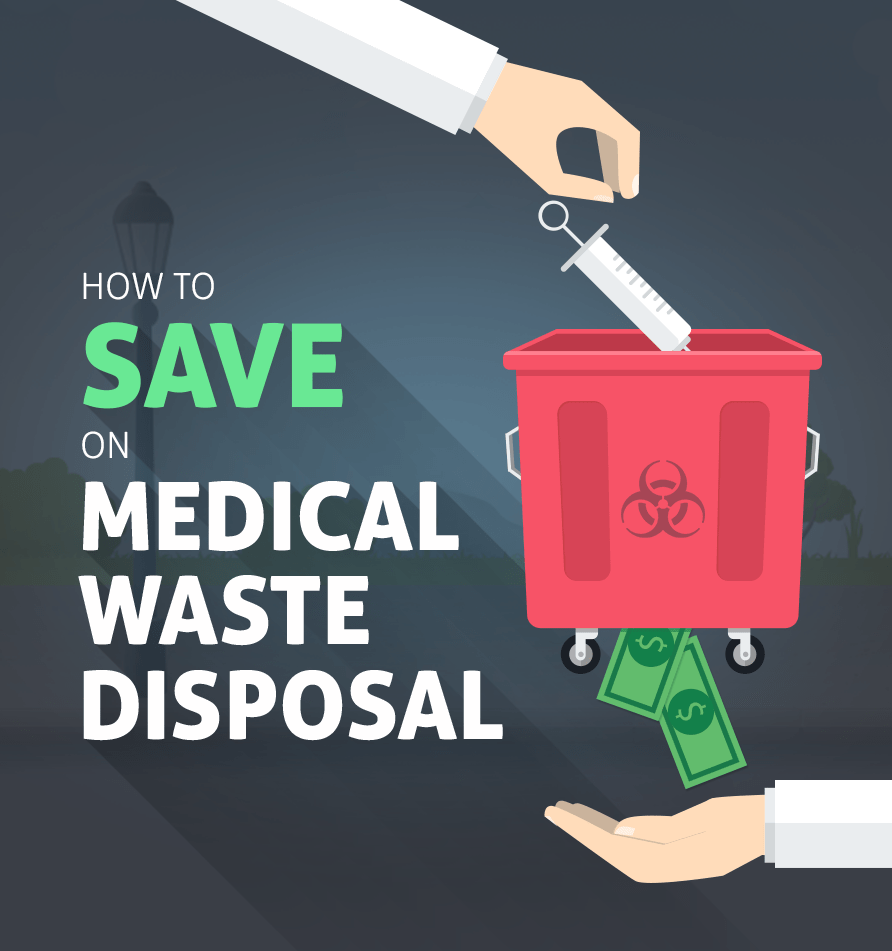Compliance and Laws for Medical Garbage Disposal
Conformity and regulations for medical waste disposal play a crucial function in making sure the safety and wellness of both healthcare specialists and the general public. Correct management of medical waste is necessary to prevent the spread of infections, secure the setting, and keep public wellness. These regulations encompass different elements, consisting of the category and partition of clinical waste, correct storage space and handling procedures, as well as transport and disposal methods.
Significance of Conformity
The relevance of compliance with guidelines for medical waste disposal can not be overemphasized. Appropriate disposal of medical waste is vital for making certain the safety and health of medical care employees, people, and the public. Medical waste, that includes things such as made use of needles, infected handwear covers, and biomedical waste, can pose significant health and wellness threats otherwise taken care of and thrown away appropriately.
Compliance with regulations guarantees that medical waste is taken care of in a means that lessens the capacity for direct exposure to transmittable conditions and dangerous substances - medical waste removal service. It assists prevent the spread of infections, such as HIV, hepatitis B and C, and various other bloodborne microorganisms. Conformity also plays a vital role in shielding the environment by protecting against contamination of water sources, soil, and air
Failing to adhere to guidelines can cause extreme consequences for medical care facilities, including penalties, legal action, and damages to their reputation. Furthermore, non-compliance might jeopardize the health and wellness and security of medical care workers, people, and the community.
Compliance with guidelines for clinical garbage disposal needs adherence to details guidelines and procedures. These may include correct segregation, packaging, labeling, and storage space of clinical waste. It additionally involves utilizing accepted disposal methods, such as incineration, landfilling, or autoclaving, depending upon the kind of waste.
Regulatory Agencies and Bodies
Regulative companies and bodies play an essential duty in looking after compliance with policies for medical garbage disposal. These companies are liable for establishing methods, standards, and requirements to make certain the secure and correct handling of clinical waste. They monitor and enforce conformity to secure public wellness and the atmosphere.
Among the most popular regulatory firms in the USA is the Epa (EPA) The EPA is in charge of controling the storage, transportation, treatment, and disposal of clinical waste. They develop guidelines for waste generators, transporters, and treatment centers to comply with, making sure that all required precautions are taken to protect against the spread of conditions and contamination.
One more essential regulatory body is the Occupational Safety And Security and Wellness Administration (OSHA) OSHA sets policies and standards to shield workers from occupational threats, consisting of those associated to clinical waste. WasteX Medical Waste Disposal. They offer standards for the risk-free handling and disposal of clinical waste to safeguard staff members in health care facilities
Along with these government companies, private states additionally have their very own regulatory bodies that manage clinical waste disposal. These agencies might have their very own particular laws and demands that must be complied with.

Category and Segregation of Medical Waste
To make certain appropriate monitoring of medical waste, it is important to categorize and segregate it according to developed standards and procedures. medical waste disposal. Category and partition play an important duty in reducing the danger of infection, safeguarding the setting, and ensuring the security of health care employees and the public
Medical waste is classified into different groups based upon its possible hazard level. These categories include contagious waste, pathological waste, sharps waste, pharmaceutical waste, chemical waste, and contaminated waste. Each group calls for details handling, disposal, transport, and storage space techniques to lessen the threat of direct exposure and contamination.
Partition of clinical waste entails dividing various kinds of waste at the resource. This procedure makes sure that waste with various danger levels is not blended, decreasing the possibility for cross-contamination and making disposal treatments a lot more effective. Appropriate segregation is achieved through the use of color-coded tags and containers, which assist health care workers and waste monitoring employees determine and manage each type of waste properly.
Along with classification and partition, medical care facilities need to likewise follow local, state, and government guidelines concerning clinical waste monitoring. These laws detail particular needs for storage, transport, therapy, and last disposal of medical waste, guaranteeing conformity and preserving public health additional reading and safety and security.
Appropriate Storage and Managing Procedures
Appropriate storage and handling treatments play an essential duty in making sure the certified and secure management of clinical waste. Clinical waste, which includes things such as utilized syringes, polluted handwear covers, and ended medicines, can pose significant wellness and ecological dangers if not handled properly. For that reason, it is critical for medical care facilities and various other generators of medical waste to carry out stringent storage and dealing with methods.
To start with, medical waste needs to be stored in resilient, watertight containers that are particularly designed for this function. These containers should be identified with the global biohazard symbol and words "clinical waste" to clearly suggest the contents. Furthermore, the containers need to be kept safely shut to avoid any kind of potential leakage or splilling.
In addition, it is very important to set apart different sorts of clinical waste to prevent cross-contamination. Sharps, such as needles and scalpels, need to be stored in puncture-resistant containers to reduce the danger of injuries - WasteX Medical Waste Disposal. Chemical waste, such as anti-bacterials and solvents, must be saved individually from various other sorts of clinical waste to stop dangerous exposures or chemical reactions

Transportation and Disposal Methods
Health care facilities should ensure the secure transport and appropriate disposal of their medical waste to adhere to guidelines and secure public health. Transport and disposal techniques play a vital function in preventing the spread of transmittable illness and reducing the ecological effect of medical waste.
To move clinical waste, healthcare centers ought to make use of leak-proof and puncture-resistant containers that are identified with the biohazard symbol. These containers must be safely sealed to avoid any kind of leak during transport. Additionally, medical care facilities need to establish methods for the transportation procedure, including making use of experienced workers and committed cars.
When the clinical waste gets to the disposal facility, it undergoes different approaches of therapy - WasteX Medical Waste Disposal. One common technique is incineration, which entails melting the waste at high temperature levels to damage pathogens and reduce the volume of waste.
It is important for health care facilities to collaborate with accredited and allowed waste administration business to make sure appropriate transportation and disposal of medical waste. These business have the experience and sources to take care of clinical waste securely and in conformity with guidelines.
Final Thought
In verdict, conformity with guidelines for clinical waste disposal is of utmost importance to make sure public health and safety. On the whole, adherence to compliance and laws is required to effectively handle medical waste.
Medical waste, which consists of products such as made use of needles, polluted gloves, and biomedical waste, can present major wellness risks if not managed and disposed of correctly.
These groups include contagious waste, pathological waste, sharps waste, pharmaceutical waste, chemical waste, and contaminated waste.Segregation of clinical waste entails separating different kinds of waste at the source. Correct segregation is accomplished via the use of color-coded containers and tags, which help health care employees and waste management workers recognize and handle each type of waste correctly.
Chemical waste, such as disinfectants and solvents, need to be stored individually from various other kinds of clinical waste to prevent unsafe direct exposures or chemical reactions.